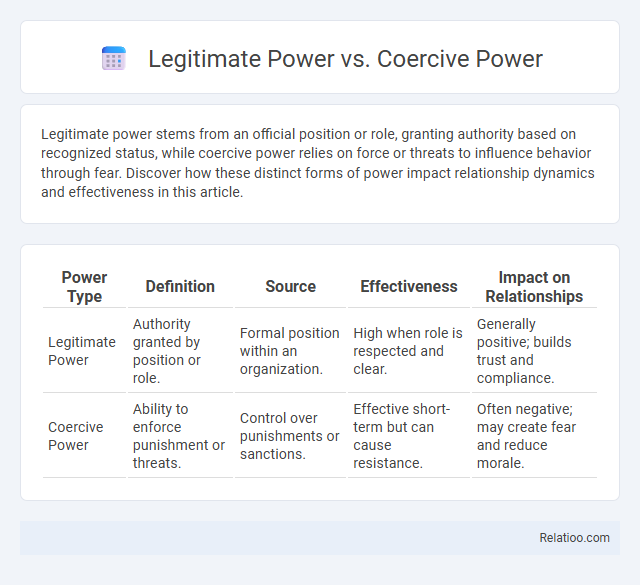Legitimate power stems from an official position or role, granting authority based on recognized status, while coercive power relies on force or threats to influence behavior through fear. Discover how these distinct forms of power impact relationship dynamics and effectiveness in this article.
Table of Comparison
| Power Type | Definition | Source | Effectiveness | Impact on Relationships |
|---|---|---|---|---|
| Legitimate Power | Authority granted by position or role. | Formal position within an organization. | High when role is respected and clear. | Generally positive; builds trust and compliance. |
| Coercive Power | Ability to enforce punishment or threats. | Control over punishments or sanctions. | Effective short-term but can cause resistance. | Often negative; may create fear and reduce morale. |
Understanding Legitimate Power
Legitimate power derives from a formal position or role within an organization, granting the authority to make decisions and request compliance. It is distinguished from coercive power, which relies on fear or threats, and obedience, which is the act of following orders regardless of the source. Understanding legitimate power highlights its foundation in accepted authority, promoting cooperation and adherence based on recognized rights.
Defining Coercive Power
Coercive power is the ability to influence behavior through threats, punishment, or fear of negative consequences, often leading to compliance without genuine agreement. You experience this form of power when someone enforces rules or demands obedience by using potential sanctions to maintain control. Unlike legitimate power, which is based on authority or role, coercive power relies on fear and the avoidance of penalties.
Key Differences Between Legitimate and Coercive Power
Legitimate power is derived from a formal position or role within an organization, often linked to established authority and accepted norms, while coercive power relies on the ability to enforce compliance through threats, punishments, or force. Legitimate power typically fosters voluntary obedience based on respect and recognition of authority, whereas coercive power generates obedience primarily through fear and pressure. The effectiveness of legitimate power is sustained by organizational structure and social contracts, contrasting with coercive power's dependence on continuous enforcement and potential resistance.
Sources of Legitimate Power
Legitimate power originates from an official position or role within an organization, granting authority recognized by both the structure and its members. This power is grounded in established norms and formal agreements, distinguishing it from coercive power, which relies on threats or punishment, and obedience, which may stem from authority or fear. Understanding these sources empowers you to effectively navigate leadership dynamics while maintaining respect and compliance.
Origins of Coercive Power
Coercive power originates from the ability to enforce compliance through threats, punishment, or force, often backed by authority or social norms that legitimize such control. It differs from legitimate power, which stems from formal roles or institutionalized authority, as coercive power relies primarily on fear and the potential for negative consequences. Obedience arises when individuals comply with commands due to the presence of coercive power or legitimate power, but coercive power specifically motivates obedience by imposing penalties for non-compliance.
Impact of Legitimate Power in Organizations
Legitimate power in organizations fosters a structure of trust and respect, enhancing employee motivation and commitment to organizational goals. This form of authority, derived from formal roles and accepted norms, positively influences decision-making efficiency and promotes a cooperative work environment. In contrast to coercive power, which often leads to resistance and low morale, legitimate power strengthens long-term organizational stability and productivity.
Consequences of Coercive Power on Workplace Culture
Coercive power in the workplace often leads to a climate of fear, decreasing employee morale and increasing turnover rates. This form of power undermines trust and collaboration, resulting in reduced creativity and productivity across teams. Prolonged reliance on coercive tactics can damage organizational culture, making it difficult to retain talent and achieve long-term business goals.
Advantages and Disadvantages of Legitimate Power
Legitimate power grants authority based on a formal role or position, providing clear structure and order within organizations, which can enhance efficiency and compliance. You benefit from predictable interactions and respect without fear, but reliance on legitimate power may lead to complacency, reduced innovation, and potential abuse if authority is unchecked. Coercive power involves forcing compliance through threats or punishment, often resulting in resistance or low morale, while obedience reflects following directives, which can be beneficial for discipline but may suppress critical thinking.
Risks and Limitations of Coercive Power
Coercive power, relying on threats and punishments, often leads to resentment, decreased morale, and high turnover, significantly harming organizational culture and productivity. Unlike legitimate power, which is based on formal authority and respect, coercive tactics undermine trust and can provoke resistance or passive compliance rather than genuine commitment. The overuse of coercive power risks creating a toxic work environment, reducing creativity, and impairing long-term obedience and loyalty from employees or subordinates.
Choosing the Right Power Approach for Effective Leadership
Choosing the right power approach is essential for effective leadership, as legitimate power bases authority on formal roles and organizational structure, fostering respect and compliance. Coercive power relies on fear and punishment, which can lead to short-term obedience but often damages trust and morale. Your leadership effectiveness improves when you balance legitimate authority with empathy, encouraging voluntary commitment rather than compliance driven solely by coercion.

Infographic: Legitimate Power vs Coercive Power
 relatioo.com
relatioo.com